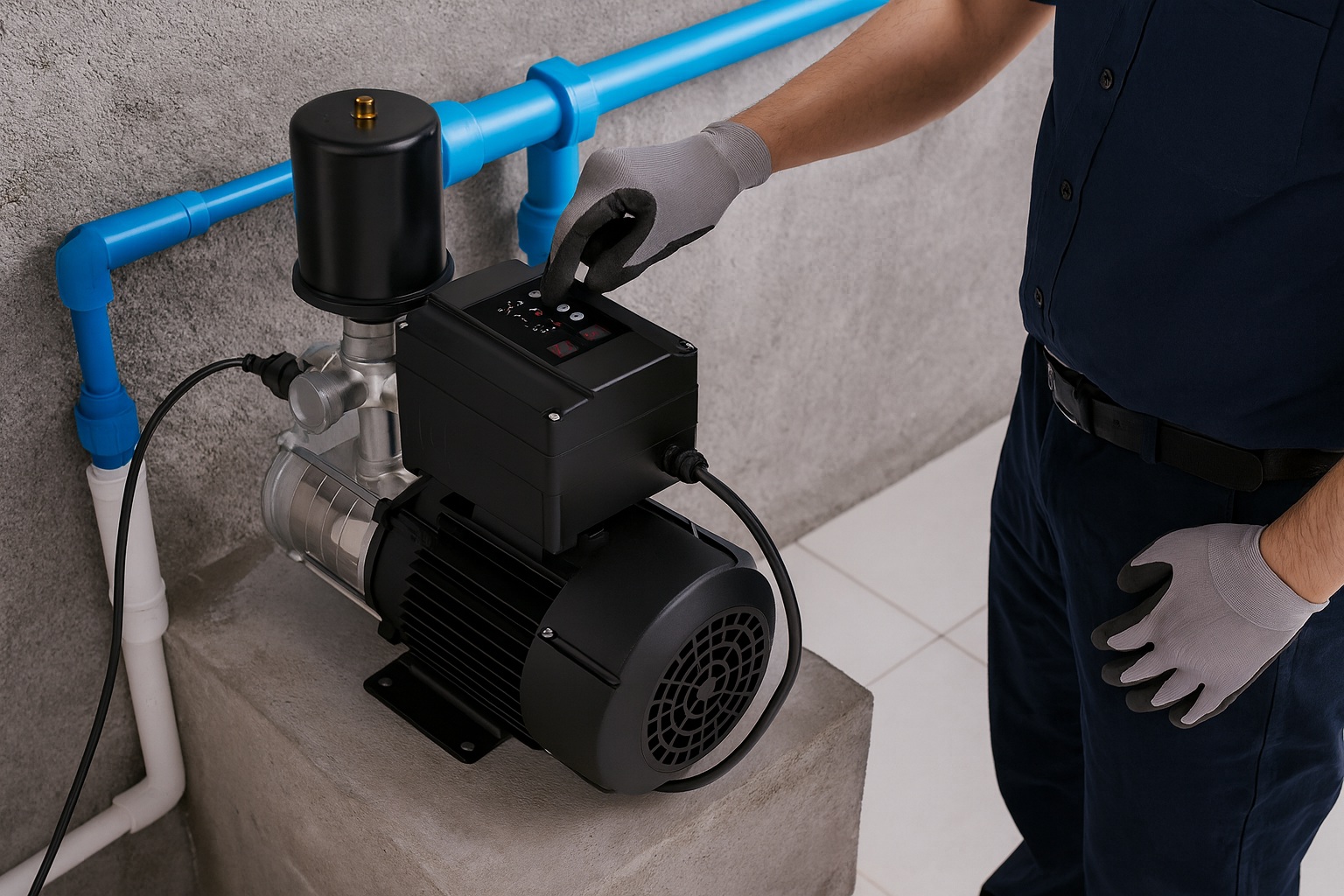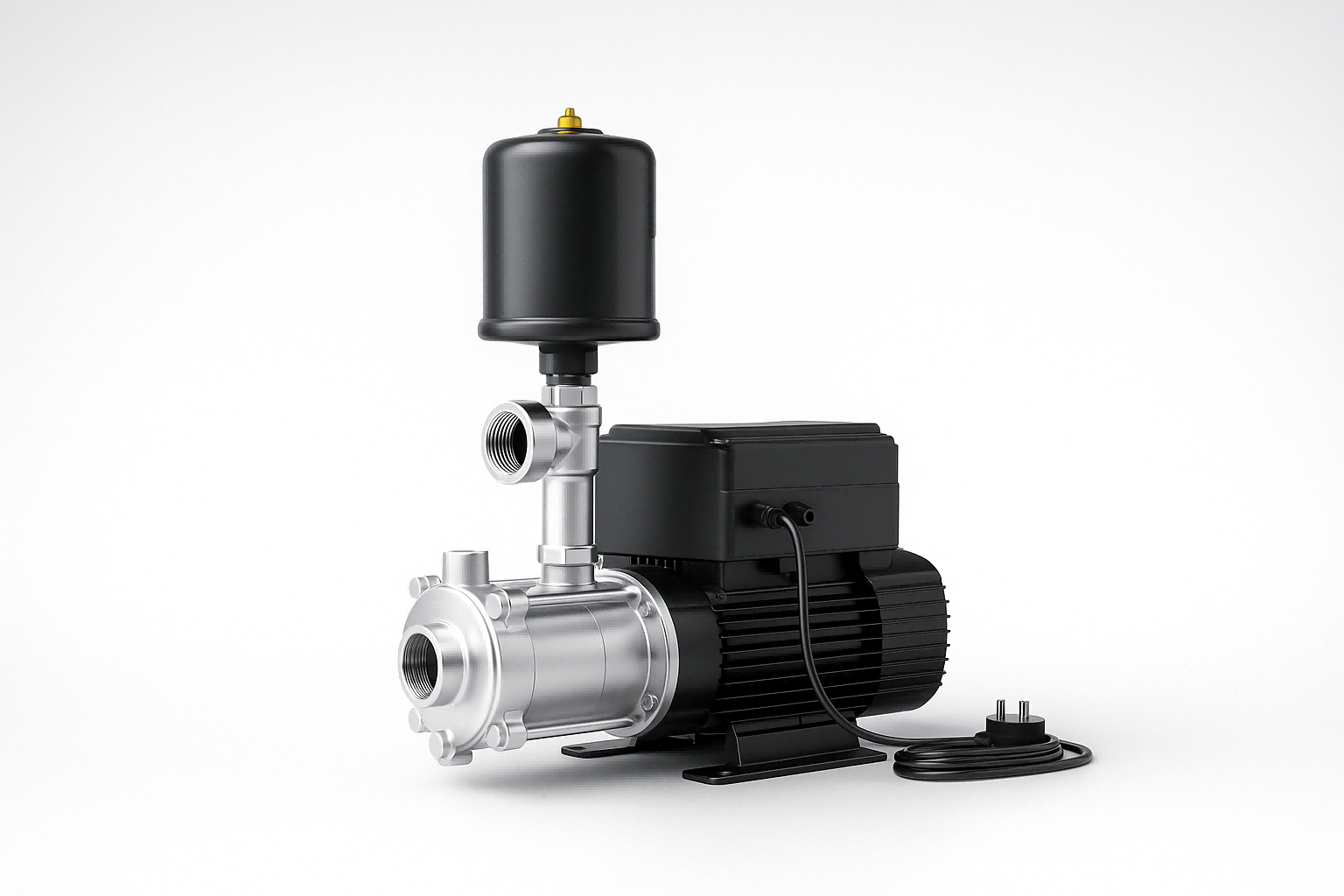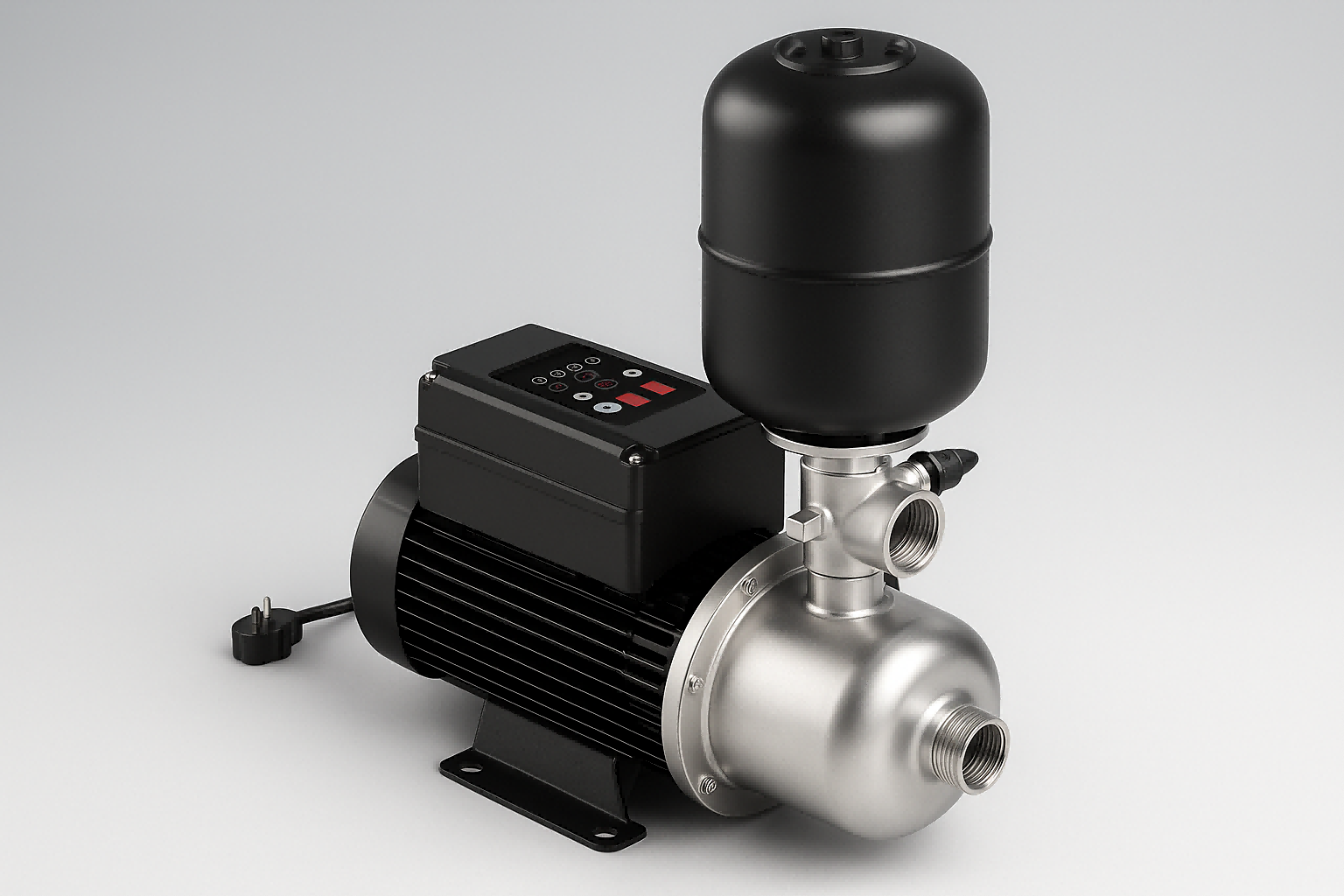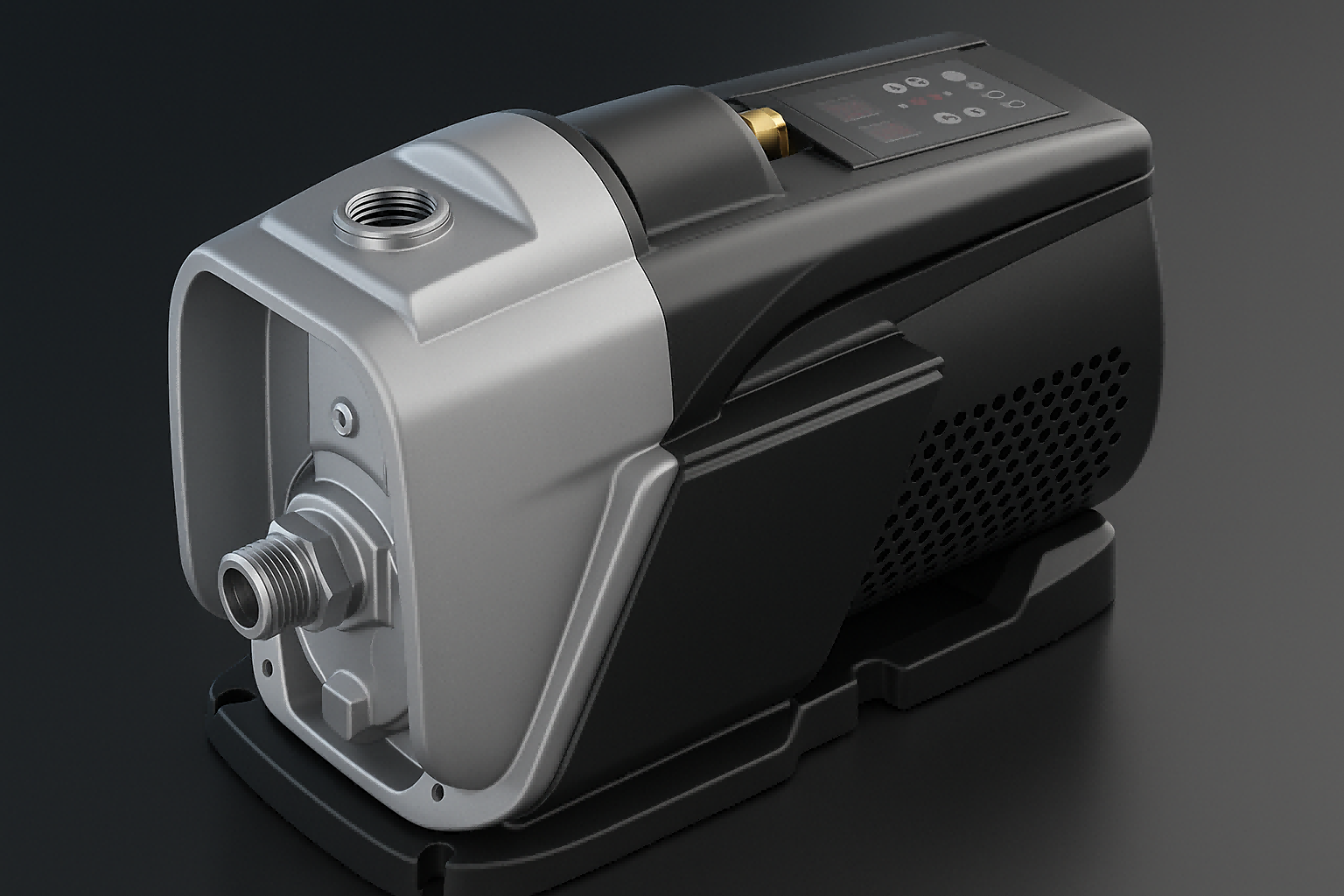Struggling with weak water flow?
Low pressure can make simple tasks frustrating.
A correctly sized pump solves this by delivering consistent, powerful water flow throughout your home.
The right size water pump for an average house typically has a flow rate of 10-15 gallons per minute (GPM) and a pressure of 40-60 PSI.
However, you must calculate your specific needs based on the number of water fixtures and the height of your home.

Choosing a water pump can feel complicated.
There are many factors to consider beyond just the size of your house.
Getting it wrong means either weak showers or wasted energy.
But don't worry, this guide will walk you through every step.
We will break down the process into simple, manageable parts.
This will help you find the perfect pump for your home's unique needs.
Let's make sure you invest in a solution that provides comfort and efficiency for years to come.
Understanding Key Pump Metrics: Flow Rate and Pressure
Is confusing pump jargon stopping you from making a decision?
Terms like GPM and PSI can sound technical.
But understanding them is the first step to ensuring your pump meets your household's demands perfectly.
Flow rate, measured in Gallons Per Minute (GPM), is the volume of water a pump can move.
Pressure, measured in Pounds per Square Inch (PSI), is the force that pushes the water through your pipes.
Balancing both is crucial for optimal performance.
To pick the right pump, you need to speak its language.
That language is all about flow and pressure.
Think of flow rate as the amount of water available.
Think of pressure as how hard that water pushes.
A pump with high flow but low pressure might fill a bucket quickly but won't be able to push water up to a second-floor shower.
Conversely, a high-pressure, low-flow pump might give you a stinging shower but can't supply enough water if a faucet is also running.
The goal is to find a pump that delivers the right amount of water with the right amount of force for your specific home.
We will now explore how these two key metrics work together and how to determine the right numbers for your system.
What is Flow Rate (GPM/LPM)?
Flow rate is the volume of water your pump can deliver over a set time.
It's usually measured in Gallons Per Minute (GPM) or Liters Per Minute (LPM).
This number tells you how many water fixtures can run at the same time without losing performance.
A low flow rate results in a weak stream when multiple taps are open.
You need to calculate your peak water demand to determine the required flow rate.
This ensures everyone in the house can use water without issue.
What is Water Pressure (PSI/Bar)?
Water pressure is the force that moves water through your plumbing system.
It is commonly measured in Pounds per Square Inch (PSI) or Bar.
Adequate pressure is needed to lift water to higher floors.
It also helps overcome friction from pipes and elbows.
Most home appliances, like washing machines and dishwashers, need a minimum pressure to operate correctly.
Standard home water pressure is typically between 40 and 60 PSI.
The Relationship Between Flow and Pressure
Flow and pressure have an inverse relationship.
This is a key concept in pump performance charts.
As you demand more flow from a pump, its ability to produce pressure decreases.
When you choose a pump, you look at its performance curve.
This curve shows you the GPM it can deliver at a specific PSI.
Your job is to find a pump whose "best efficiency point" on the curve matches your home's requirements for both flow and pressure.
A variable speed drive (VSD) pump can adjust its speed to maintain constant pressure even when the flow demand changes.
This makes VSD pumps a highly efficient and effective solution.
Table: Common Appliance Pressure and Flow Requirements
| Appliance/Fixture | Typical Flow Rate (GPM) | Minimum Pressure (PSI) |
|---|---|---|
| Kitchen Faucet | 1.5 - 2.5 | 30 |
| Bathroom Faucet | 1.0 - 1.5 | 30 |
| Standard Shower | 2.0 - 2.5 | 35 |
| Washing Machine | 2.0 - 4.0 | 30 |
| Dishwasher | 1.5 - 2.5 | 25 |
| Garden Hose | 4.0 - 5.0 | 40 |
Calculating Your Home's Water Demand (Flow Rate)
Ever had the shower turn into a trickle when someone flushes a toilet?
This annoying problem comes from underestimating your home's water demand.
Calculating your peak usage is the only way to ensure your pump can handle the load.
To calculate your home's required flow rate, count the number of water fixtures you have.
Assign a GPM value to each one.
Then, add up the GPM for all fixtures that could realistically run at the same time to find your peak demand.
Guessing your flow rate is a recipe for disappointment.
A systematic approach is much better.
You don't need a pump that can power every single faucet in your house at full blast simultaneously.
That would be incredibly oversized and inefficient.
Instead, you need to think about a realistic "peak use" scenario.
What is the busiest time for water usage in your home?
Maybe it's the morning, with one person showering, another using the bathroom sink, and the dishwasher running from the night before.
This is the number you need to plan for.
By accurately calculating this peak demand, you choose a pump that performs reliably under pressure without being excessively large or costly to run.
Let's break down exactly how to do this calculation.
Step 1: List All Water Fixtures
The first step is to create a complete inventory of every place water comes out in your house.
Walk through your home and list everything.
Don't forget outdoor spigots, irrigation systems, and utility sinks.
A thorough list is the foundation for an accurate calculation.
It’s easy to forget a fixture, so be methodical.
Common Household Water Fixtures:
- Toilets
- Showers
- Bathtubs
- Bathroom Sinks
- Kitchen Sinks
- Dishwashers
- Washing Machines
- Utility Sinks
- Outdoor Hose Bibs
- Irrigation Systems
- Water Heaters
Step 2: Assign Flow Rates to Each Fixture
Each fixture has a typical flow rate.
You can often find this information stamped on the fixture itself or in its product manual.
If not, you can use standard values.
Modern, high-efficiency fixtures use less water than older models.
Using accurate numbers for your specific fixtures will give you a more precise result.
Table: Standard Fixture Flow Rates (GPM)
| Fixture | Standard Flow Rate (GPM) | High-Efficiency Flow Rate (GPM) |
|---|---|---|
| Toilet (per flush) | 3.5 | 1.6 |
| Shower Head | 2.5 | 2.0 |
| Bathtub Faucet | 4.0 | 4.0 |
| Bathroom Sink | 1.5 | 1.0 |
| Kitchen Sink | 2.2 | 1.8 |
| Dishwasher | 2.0 | 1.5 |
| Washing Machine | 2.5 | 2.0 |
| Outdoor Spigot | 5.0 | 5.0 |
Step 3: Determine Your Peak Demand
Now, think about your family's daily routine.
You are unlikely to ever have everything running at once.
The key is to identify the maximum number of fixtures that might be used simultaneously during a busy period.
For a typical family, this might be two showers and a toilet flush.
Or it could be a shower, the washing machine, and the kitchen sink.
Add up the GPM for that specific scenario.
This total is your required peak flow rate.
For example, if two high-efficiency showers (2.0 GPM each) and one kitchen sink (1.8 GPM) are running, your peak demand is 2.0 + 2.0 + 1.8 = 5.8 GPM.
It's wise to add a small buffer, maybe 10-20%, to this number.
So, a pump capable of delivering around 7 GPM would be a good starting point for this household.
Determining the Required Water Pressure (PSI/Bar)
Is your second-floor shower disappointingly weak?
This is often a problem of inadequate pressure, not flow.
You need enough force to push water vertically and through your pipe network to every tap.
To determine the required pressure, consider your home's total height (or "head"), the friction loss from pipes, and the desired pressure at the faucet.
A general rule is to add 5 PSI for every 10 feet of vertical lift needed.
Calculating the required pressure is as critical as determining the flow rate.
Pressure is what gives your water its "get-up-and-go."
Without sufficient PSI, water will struggle to reach the highest points in your home.
It will also fail to overcome the natural resistance it encounters while traveling through pipes, fittings, and valves.
The total pressure your pump needs to generate is called the "Total Dynamic Head."
This sounds complex, but it's just a combination of three factors: the vertical lift, the friction inside the pipes, and the final pressure you want at the tap.
Let's examine how to figure out each of these components to find the perfect pressure rating for your new pump.
Calculating Vertical Lift (Static Head)
Vertical lift, or static head, is the vertical distance from your pump to the highest water outlet in your home.
For a well pump, this distance is from the water level in the well to that highest outlet.
Measure this height in feet.
Water is heavy, and gravity works against the pump.
It takes a specific amount of energy to lift it.
The rule of thumb is that for every 2.31 feet of height, you need 1 PSI of pressure to overcome gravity.
A simpler way to estimate is to add 5 PSI for every 10 feet of vertical distance.
For a two-story house, you might need an extra 10-15 PSI just for the lift.
Accounting for Friction Loss
Water doesn't flow through pipes effortlessly.
It rubs against the inner walls of the plumbing, creating friction.
This friction slows the water down and reduces pressure.
Several factors influence the amount of friction loss:
- Pipe Length: Longer pipes create more friction.
- Pipe Diameter: Narrower pipes create significantly more friction than wider pipes.
- Pipe Material: Rougher materials like old galvanized steel create more friction than smooth PVC or copper.
- Fittings: Every elbow, tee, and valve adds to the total friction.
Accurately calculating friction loss can be complex and often requires charts.
However, for a standard home, a common practice is to add a percentage of the static head calculation.
A good estimate is to add 20-30% to your pressure calculation to account for friction loss.
Establishing Desired Operating Pressure
Finally, you need water to come out of the tap with usable force.
Most people find a pressure of 40-50 PSI at the fixture to be comfortable and effective.
This is your desired operating pressure.
So, your pump's total required pressure is the sum of these three factors.
Formula for Total Required Pressure (PSI):
(Total Vertical Lift in Feet / 2.31) + Friction Loss (estimated) + Desired Fixture Pressure
Example Calculation:
Let's say your highest shower head is 25 feet above the pump.
You want 45 PSI at that shower head.
- Pressure for Lift: 25 feet / 2.31 = 10.8 PSI (or roughly 12.5 PSI using the 5 PSI per 10 feet rule)
- Pressure for Friction: Let's estimate friction loss as 30% of the lift pressure. 10.8 PSI * 0.30 = 3.2 PSI.
- Desired Pressure: 45 PSI.
- Total Required Pump Pressure: 10.8 + 3.2 + 45 = 59 PSI.
In this case, you would look for a pump capable of delivering your target GPM at a pressure of at least 60 PSI.
Types of Household Water Pumps: Which is Right for You?
Feeling overwhelmed by the different types of water pumps available?
Jet pumps, submersibles, and booster pumps all serve different purposes.
Choosing the wrong type can lead to poor performance and an early replacement.
The right type of pump depends mainly on your water source.
Submersible pumps are best for deep wells.
Jet pumps are great for shallow wells.
Booster pumps are used to increase pressure from a municipal supply or storage tank.
Once you know your required flow rate and pressure, the next step is to select the correct pump category.
The pump's design determines how it moves water and where it is most effective.
Installing a shallow well pump on a deep well simply won't work.
Using a submersible pump to boost city water pressure would be inefficient and improper.
Each type is engineered for a specific application.
Understanding the basic function of each will help you narrow down your options significantly.
This ensures you are investing in a tool that is perfectly suited for the job at hand.
Let's look at the most common types of household pumps and see which one fits your situation.
Submersible Well Pumps
Submersible pumps are long, cylindrical pumps designed to be placed deep inside a well casing, completely submerged in water.
They are highly efficient because they push water up to the surface rather than pulling it.
This makes them the best choice for deep wells, typically those deeper than 25 feet.
They are known for their reliability and quiet operation since the pump is located down in the well.
They tend to be more expensive than jet pumps but are more powerful and durable for deep well applications.
Jet Pumps
Jet pumps are located above ground, usually in a well house or basement.
They work by creating a vacuum to suck water up from the source.
There are two main varieties:
- Shallow Well Jet Pumps: These use a single pipe to draw water from depths of up to 25 feet.
- Deep Well Jet Pumps: These use a two-pipe system to draw water from depths between 25 and about 110 feet.
Jet pumps are generally less expensive and easier to access for maintenance.
However, they are less efficient than submersibles and can be noisier.
Booster Pumps
A booster pump is not used to draw water from a source.
Instead, it is used to increase the pressure of water that is already flowing in your pipes.
These are the ideal solution if you have low water pressure from your municipal supply.
They are also used with rainwater harvesting tanks or storage tanks to provide adequate pressure throughout the house.
Intelligent VSD (Variable Speed Drive) booster pumps, like those offered by RAFSUN, are the most advanced type.
They automatically adjust their motor speed to maintain a constant, pre-set pressure.
This is incredibly energy-efficient and provides a superior user experience with no pressure fluctuations.
Table: Comparing Pump Types
| Pump Type | Best Application | Pros | Cons |
|---|---|---|---|
| Submersible Pump | Deep wells (over 25 ft) | Highly efficient, quiet, reliable | More expensive, harder to access |
| Shallow Well Jet | Shallow wells (under 25 ft) | Inexpensive, easy to maintain | Can lose prime, less efficient |
| Deep Well Jet | Wells from 25 ft to 110 ft | Above-ground access for maintenance | More complex installation, less efficient |
| Booster Pump (VSD) | Boosting existing low pressure (city/tank) | Constant pressure, very energy-efficient, quiet | Higher initial cost |
The Impact of Water Source on Pump Selection
Do you know where your water comes from?
Your water source—be it a deep well, city supply, or a large tank—is the single most important factor in choosing a pump.
A pump designed for a well will fail if used to boost city pressure.
The depth and type of your water source dictate the pump category you need.
Deep wells require submersible pumps, shallow sources use jet pumps, and boosting pressure from a municipal line or tank requires a booster pump.
Starting here prevents costly mistakes.
Before you even think about GPM or PSI, you must identify your water source.
This is the starting point of your entire selection process.
The pump's fundamental design is built around how it gets water into your system.
A pump that pulls water up from 100 feet deep is a very different machine from one that takes already-pressurized city water and just adds a little more force.
Using the wrong type of pump for your source is not just inefficient; it can damage the pump and even your plumbing system.
It's a foundational decision that impacts every other choice you'll make.
Let's clearly define the common water sources and match them with the appropriate pump technology to ensure you start on the right path.
Private Well Systems
If your home uses a private well, the first thing you need to know is its depth.
Specifically, you need the "static water level," which is the distance from the ground surface down to the water.
- Shallow Wells (less than 25 feet): For wells where the water level is 25 feet or less from the surface, a shallow well jet pump is the most common and cost-effective choice. It sits above ground and pulls the water up.
- Deep Wells (more than 25 feet): If the water level is deeper than 25 feet, a jet pump cannot create enough suction. You will need a submersible pump. The pump is lowered into the well and pushes water to the surface, which is a much more efficient method for greater depths.
Municipal or City Water Supply
Many homes are connected to a municipal water supply.
In this case, you don't need to draw water from a source.
The water is already delivered to your home under some pressure.
However, this pressure is often too low, especially in large homes, multi-story buildings, or areas far from the municipal pumping station.
The solution here is a booster pump.
This pump is installed on your main water line after the meter.
It takes the incoming city pressure and increases it to your desired level, ensuring strong, consistent flow throughout the house.
A VSD booster pump is ideal here, as it only runs as much as needed to maintain pressure, saving energy.
Rainwater Harvesting or Storage Tanks
An increasing number of homes use rainwater harvesting systems or large storage tanks.
Water from these sources has no natural pressure.
You need a pump to draw water from the tank and pressurize it for use in the home.
The right pump depends on the tank's location.
If the pump can be placed below the tank's water level, a standard centrifugal pump or booster pump can work.
If the pump must be placed above the water level, you will need a self-priming pump, like a jet pump, that can create suction to lift the water from the tank.
Again, a VSD booster system is an excellent choice for pressurizing water from a tank, providing constant pressure and efficient operation.
Sizing Your Pump for Energy Efficiency
Worried about your electricity bill after installing a new pump?
An oversized pump is a notorious energy hog, running inefficiently and costing you money every month.
Sizing for efficiency is as important as sizing for performance.
For maximum energy efficiency, choose a pump that is correctly sized for your needs and consider a Variable Speed Drive (VSD) model.
VSD pumps adjust their speed to match water demand, reducing electricity consumption by up to 50% or more compared to fixed-speed pumps.
In the past, the only option was a fixed-speed pump.
It turned on at full power and turned off when it hit a certain pressure.
This "on-off" cycle is inefficient.
It's like driving your car by only flooring the accelerator or slamming on the brakes.
This approach uses a surge of electricity every time it starts, puts stress on the motor, and can cause annoying pressure fluctuations in your home.
Modern pump technology offers a much smarter solution.
Variable Speed Drive (VSD) technology, also known as Variable Frequency Drive (VFD), completely changes the game.
It allows the pump to be a strategic part of your home's utility system, saving you a significant amount of money over the pump's lifespan while delivering superior comfort.
How Traditional Pumps Waste Energy
A traditional, fixed-speed pump is sized for your peak demand.
However, most of the time, your home's water usage is far below that peak.
You might only be using a single faucet, which requires very little flow.
The fixed-speed pump doesn't know this.
It runs at 100% power anyway, pumping hard against a pressure switch until it shuts off.
This constant, high-power cycling is mechanically stressful and electrically inefficient.
It is the primary source of wasted energy in conventional water systems.
The VSD Pump Advantage
A VSD pump has a sophisticated controller that senses the pressure in your water system.
You set a desired pressure, for example, 50 PSI.
When you turn on a faucet, the pressure starts to drop.
The VSD controller detects this and tells the pump motor to start spinning, but only as fast as needed to maintain that 50 PSI.
If you turn on another faucet, the controller senses a larger pressure drop and speeds the motor up.
When you turn the faucets off, it slows the motor down.
This intelligent operation has several key benefits:
- Massive Energy Savings: The power a pump uses is exponentially related to its speed. Running at 50% speed can use as little as 15-20% of the energy of running at full speed. This is where the savings of up to 50% or more come from.
- Constant Water Pressure: You get a true "city-like" water experience. No more pressure drops when someone else uses water. The shower stays strong and steady.
- Longer Pump Life: The "soft start" nature of a VSD reduces mechanical and electrical stress on the motor and pump components, leading to a longer, more reliable service life.
- Quiet Operation: Because the pump rarely runs at full speed, it is significantly quieter than a traditional pump that is constantly slamming on and off.
Is a VSD Pump Right for You?
While the initial investment for a VSD pump can be higher than a conventional pump, the return on investment is often very quick.
The significant energy savings, combined with increased comfort and longer equipment lifespan, make it a compelling choice for most homeowners.
If you are looking for the most efficient, reliable, and comfortable water supply solution, a VSD booster pump is the modern standard.
Common Sizing Mistakes and How to Avoid Them
Have you ever bought a pump that was too powerful or too weak?
A simple mistake in pump sizing can lead to years of frustration.
Avoiding these common pitfalls is key to a successful installation.
The biggest sizing mistakes are oversizing the pump, which wastes energy, and undersizing it, which results in poor performance.
Other errors include ignoring friction loss and miscalculating the total vertical lift (head).
Always double-check your calculations.
Choosing a water pump is a significant investment in your home's comfort and functionality.
Getting it right from the start saves you time, money, and hassle down the road.
Many people make predictable, avoidable errors during the selection process.
They might rely on a simplistic rule of thumb, guess their water needs, or buy a bigger pump "just in case."
These approaches often lead to regret.
A system that is a perfect fit will be more efficient, last longer, and deliver the performance you expect.
Let's review the most common sizing blunders so you can approach your purchase with the confidence of an expert.
Mistake 1: "Bigger is Better"
This is the most frequent and costly error.
Homeowners often think buying a pump with more horsepower than they need is a safe bet.
In reality, an oversized pump is highly inefficient.
It will short-cycle, turning on and off rapidly, which dramatically increases energy consumption and puts immense stress on the motor and electrical components.
This leads to a higher electricity bill and a much shorter lifespan for the pump.
How to Avoid: Trust your calculations. Don't be tempted to buy a bigger pump "just in case." A correctly sized pump that runs longer but less frequently is far more efficient and durable.
Mistake 2: Ignoring Friction Loss
Many people calculate the pressure needed for vertical lift but forget about the pressure lost to friction.
They install a pump that seems perfect on paper, only to find the pressure at the farthest faucet is disappointingly low.
Friction loss from long pipe runs, narrow pipes, and numerous fittings can add up to a significant pressure drop.
How to Avoid: Always include an estimate for friction loss in your total pressure calculation. Adding 20-30% to your vertical lift pressure requirement is a safe rule of thumb for most homes.
Mistake 3: Miscalculating Total Head
This mistake is common in well pump installations.
People might measure the depth of their well but forget to use the static water level as the starting point for their calculation.
Or, they measure the vertical distance to the pressure tank but forget to add the additional height to the second-floor shower.
How to Avoid: Be precise in your measurements. The total vertical lift is the distance from the water source's surface (in the well or tank) to the highest point water will be used in your home.
Mistake 4: Underestimating Peak Demand
A family might calculate their needs based on one person showering.
They forget that during busy mornings, the dishwasher might be running and another person could be using a sink.
This leads to an undersized pump that cannot keep up, causing pressure to drop for everyone when multiple fixtures are on.
How to Avoid: Be realistic about your family's lifestyle. Brainstorm the busiest possible water-use scenario in your home and use that as the basis for your GPM calculation. It's better to plan for this peak, even if it only happens for a few minutes each day.
Conclusion
Choosing the right water pump doesn't have to be complicated.
By calculating your flow and pressure needs and selecting the right type, you ensure a reliable, efficient system for years.
FAQs
What happens if my water pump is too big for my house?
An oversized pump will cycle on and off too frequently.
This wastes a lot of energy and causes premature wear on the pump's motor, leading to a shorter lifespan.
How many GPM does a typical house use?
A typical American household uses between 10 and 15 GPM during peak demand.
However, you should always calculate your specific needs based on your fixtures and family size.
What is a good PSI for a house water pump?
A good operating pressure for a house is between 40 and 60 PSI.
This range provides a strong flow for showers and is safe for plumbing and appliances.
Can I install a water pump myself?
While some homeowners can handle the installation, it often involves both plumbing and electrical work.
If you are not experienced, it is highly recommended to hire a professional plumber.
How long does a house water pump last?
The lifespan of a water pump varies by type and quality.
A good quality well pump can last 8 to 15 years, while a booster pump may last a similar amount of time.
Is a booster pump always on?
A traditional booster pump cycles on and off based on a pressure switch.
A modern VSD booster pump is technically always "on" but runs its motor at varying speeds to save energy.
Do I need a pressure tank with a VSD booster pump?
A small pressure tank is often recommended with a VSD pump.
It helps smooth out small pressure changes and can reduce how often the pump needs to make minor speed adjustments.
How much electricity does a VSD pump save?
Compared to a conventional fixed-speed pump, a VSD pump can save a significant amount of energy, often between 30% and 60%, by precisely matching motor speed to water demand.








